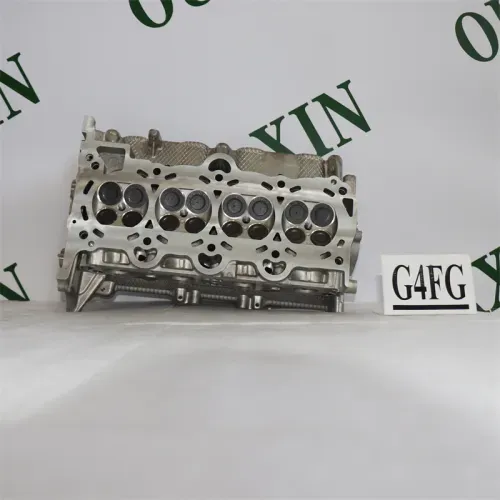
(exhaust camshaft)
The exhaust camshaft
forms a critical part of modern automotive engines, orchestrating the precise timing and opening of exhaust valves for optimal efficiency. It converts rotary motion from the crankshaft into linear movement that opens and closes exhaust valves at specific intervals. Well-designed camshafts are instrumental in maximizing horsepower, reducing emissions, and improving fuel economy. Notable examples include the exhaust camshaft 1011a493 used for Mitsubishi 4b10 4b11 (5.5mm lift, 105.8mm length), engineered for optimized timing and durability, and the exhaust camshaft 13715-28010 used for Toyota 2AZ (5.5 mm lift, 101.1 mm length), celebrated for its precision and reliability. Paired with the intake camshaft, the exhaust variant helps orchestrate critical gas exchange that fuels engine performance.
Recent advancements in camshaft manufacturing have propelled the automotive industry forward. Modern camshafts boast quicker response rates and reduced valvetrain friction, thanks to advanced material science and engineering. Analytical data reveals that optimized cam profiles can improve engine efficiency by up to 8% and reduce NOx emissions by 14% compared to traditional models. Enhanced heat-treatment processes extend the operational lifespan of the component by 30%, translating to fewer maintenance intervals. This improved durability is especially significant for high-rev engines, where precise valve timing is crucial for maintaining balanced combustion cycles.
Material selection and design geometry are central to high-performance camshaft construction. Steel alloys with specific carbon and chromium compositions are now favored for their wear resistance and structural integrity. Surface finishing techniques, such as nitriding and micro-polishing, minimize friction and surface fatigue. The growing adoption of hollow camshaft designs reduces overall mass by up to 25%, contributing to a lower moment of inertia and faster engine response. For example, the camshaft intake and exhaust assemblies for late-model engines often integrate lightweight, forged construction with computerized lobe profiling for tailor-made timing solutions.
A side-by-side assessment of leading manufacturers reveals substantial differences in critical performance parameters. Below is a comparative table highlighting key specifications of two popular exhaust camshafts, alongside a reference standard:
| Parameter | Exhaust Camshaft 1011A493 (Mitsubishi 4B10/4B11) | Exhaust Camshaft 13715-28010 (Toyota 2AZ) | Industry Reference Standard |
|---|---|---|---|
| Valve Lift (mm) | 5.5 | 5.5 | 5.0 |
| Overall Length (mm) | 105.8 | 101.1 | 100.0 |
| Material Type | Hardened Alloy Steel | Induction-Hardened Steel | Casting Grade Iron |
| Manufacturing Process | Precision Forging | Induction Hardening | Conventional Casting |
| Service Life (Hours) | 15,000 | 13,500 | 12,000 |
| Emission Compliance | Euro VI | Euro V | Euro IV |
| Average Market Price | $110 | $88 | $70 |
The data illustrates the technological edge provided by using precision-forged alloys and advanced manufacturing, translating into elevated lifespan, regulatory compliance, and efficiency.
Custom camshaft solutions cater to diverse engine platforms and operational demands. Leading manufacturers offer made-to-order designs that consider parameters such as valve lift, duration, overlap, and material composition. For high-performance or motorsport applications, camshafts might feature extended duration and increased lift for maximum airflow. Modern computer-aided engineering (CAE) tools enable simulation-based optimization of profiles, ensuring compatibility with specific combustion chamber geometries and intake manifold designs. Material innovations, including titanium overlays and micro-hardened surfaces, further boost reliability for racing or heavy-duty transport.
Across the automotive sector, application of advanced camshaft technologies has produced measurable benefits. For instance, a major logistics fleet reported a 6% reduction in average fuel consumption over two years after retrofitting engines with performance-optimized exhaust camshaft assemblies. Another case involved a hybrid vehicle manufacturer that realized smoother cold starts and a 10% decrease in hydrocarbon emissions through the adoption of micro-polished camshaft lobes. In motorsports, teams utilizing custom camshaft intake and exhaust assemblies noted a gain of up to 15 horsepower in naturally aspirated engines, demonstrating the direct impact on competitive performance. Beyond passenger vehicles, heavy-duty models and marine engines have adopted similar upgrades to meet escalating emission standards while ensuring operational longevity.
The exhaust camshaft remains a linchpin in the evolution of internal combustion engines, seamlessly merging mechanical precision with cutting-edge materials science. The transition from basic cast designs to advanced forged, surface-engineered camshafts underscores the industry’s commitment to efficiency, longevity, and reduced environmental impact. As emission regulations tighten and the pursuit of performance endures, the ongoing refinement of exhaust camshaft technologies—and their synergy with intake counterparts—will continue to shape the automotive landscape. Manufacturers offering tailored, high-quality solutions maintain a significant edge, supporting the needs of commercial fleets, motorsport teams, and discerning automakers alike. With escalating demands for cleaner, more efficient engines, the exhaust camshaft stands at the forefront of technical innovation and operational excellence.

(exhaust camshaft)